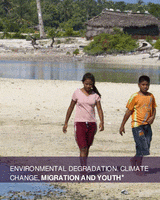Environmental degradation, climate change, migration and youth
Schraven, BenjaminExterne Publikationen (2014)
in: Jeronimo Cortina, Patrick Taran, Alison Raphael (eds.), Migration and youth: challenges and opportunities, Global Migration Group by the United Nations Children’s Fund, 1-9
Within the debates on the consequences of climatic and ecological change, international attention has become increasingly focussed on the links between environmental change and migration. Several international organisations such as UNHCR, UNFCCC, IOM and UNICEF are addressing this issue. Furthermore, a series of research initiatives focusing on the link between environmental change and migration has been set up in recent years. These include projects such as Environmental Change and Forced Migration Scenari os (EACH FOR), the Foresight: Migration and Global Environmental Change project and “Where the rain falls”. First of all, the studies mentioned come to the conclusion that in the majority of cases, it is not only environmental change in the form of rapid-onset events (storms, flood events, etc.) or gradual processes of ecological change (soil erosion, sea-level rise, etc.) that cause people to migrate. It is rather a complex set of interrelated environmental, socio-economic, cultural, political and demographic factors that influences or drives migration decisions. This leads to a severe identification problem: there are no uniform criteria or variables indicating that the effects of environmental change may be deemed to be so strong that related human migration processes actually can be considered environmentally induced. Accordingly, the complexity of the interlinkages between environmental change and migration makes it necessary to develop definitions and categories, which are universally accepted. Furthermore, there is still a huge demand for advancing the knowledge base concerning the interactions between environmental change, migration and its potential consequences. This is particularly valid for the affectedness and specific vulnerability of children, adolescents and youth as well as other population segments (e.g. women, elders) in this context. This book chapter explores some policy options in this regard.


